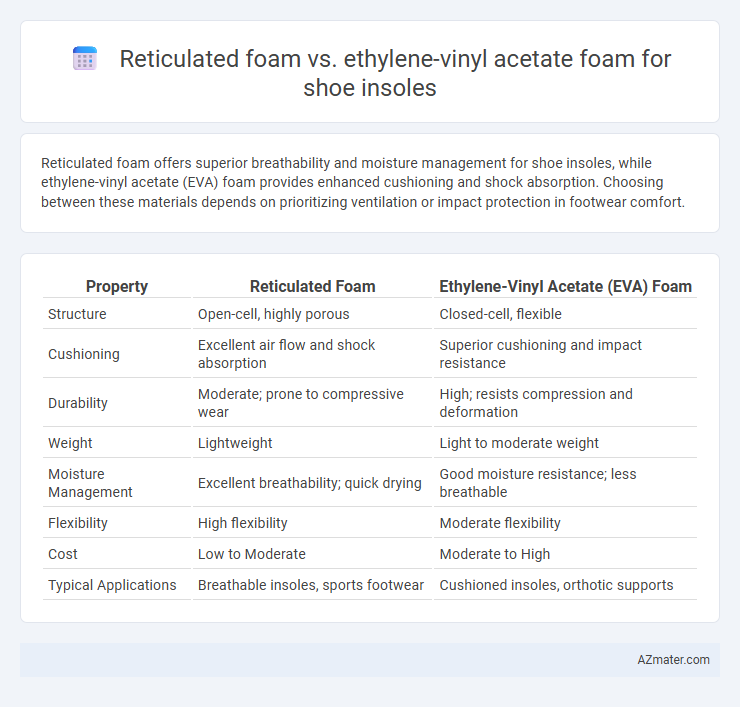Reticulated foam offers superior breathability and moisture management for shoe insoles, while ethylene-vinyl acetate (EVA) foam provides enhanced cushioning and shock absorption. Choosing between these materials depends on prioritizing ventilation or impact protection in footwear comfort.
Table of Comparison
| Property | Reticulated Foam | Ethylene-Vinyl Acetate (EVA) Foam |
|---|---|---|
| Structure | Open-cell, highly porous | Closed-cell, flexible |
| Cushioning | Excellent air flow and shock absorption | Superior cushioning and impact resistance |
| Durability | Moderate; prone to compressive wear | High; resists compression and deformation |
| Weight | Lightweight | Light to moderate weight |
| Moisture Management | Excellent breathability; quick drying | Good moisture resistance; less breathable |
| Flexibility | High flexibility | Moderate flexibility |
| Cost | Low to Moderate | Moderate to High |
| Typical Applications | Breathable insoles, sports footwear | Cushioned insoles, orthotic supports |
Introduction to Shoe Insole Materials
Reticulated foam and ethylene-vinyl acetate (EVA) foam are popular materials used in shoe insoles, each offering distinct benefits in cushioning and durability. Reticulated foam provides superior breathability and rapid moisture drainage due to its open-cell structure, making it ideal for high-performance or athletic footwear. EVA foam delivers excellent shock absorption and flexibility while maintaining lightweight support, commonly favored in casual and running shoe insoles for enhanced comfort and impact resistance.
What is Reticulated Foam?
Reticulated foam is a highly porous, open-cell material made by removing cell membranes from polyurethane foam, resulting in a strong, breathable structure ideal for shoe insoles. It excels in moisture management and air permeability, providing enhanced comfort and odor control compared to Ethylene-vinyl acetate (EVA) foam, which is denser and offers more cushioning but less ventilation. Reticulated foam's durability and quick-drying properties make it a preferred choice for athletic and outdoor footwear insoles.
What is Ethylene-Vinyl Acetate (EVA) Foam?
Ethylene-Vinyl Acetate (EVA) foam is a lightweight, flexible material known for its excellent shock absorption and cushioning properties, making it ideal for shoe insoles. Its closed-cell structure provides durability and water resistance, enhancing comfort and foot support during prolonged wear. Compared to reticulated foam, EVA offers better impact protection and resilience, which improves overall foot stability in various footwear applications.
Cushioning Properties: Reticulated Foam vs EVA Foam
Reticulated foam offers superior breathability and shock absorption due to its open-cell structure, making it ideal for high-impact cushioning in shoe insoles. Ethylene-vinyl acetate (EVA) foam provides a more consistent and durable cushioning with excellent energy return, favored for long-lasting comfort and support. While reticulated foam excels in ventilation and quick recovery, EVA foam stands out for its balance of softness and resilience in footwear applications.
Breathability and Moisture Management Comparison
Reticulated foam offers superior breathability due to its open-cell structure, allowing air to circulate freely and effectively dissipate heat inside the shoe. Ethylene-vinyl acetate (EVA) foam, while cushioning well, has a closed-cell composition that limits airflow and traps moisture, reducing overall moisture management. Consequently, reticulated foam excels in maintaining a dry, comfortable environment in the shoe, making it ideal for high-performance or athletic insoles.
Durability and Longevity: Which Foam Lasts Longer?
Reticulated foam offers superior breathability and water drainage but typically exhibits less durability compared to Ethylene-vinyl acetate (EVA) foam, which is renowned for its resilience and ability to retain cushioning over time. EVA foam resists compression set and maintains structural integrity under prolonged stress, making it the preferred choice for long-lasting shoe insoles. While reticulated foam excels in moisture management, EVA foam's durability ensures extended lifespan and sustained comfort in footwear applications.
Comfort and Foot Support Analysis
Reticulated foam offers superior breathability and cushioning, making it ideal for absorbing shock and enhancing comfort in shoe insoles. Ethylene-vinyl acetate (EVA) foam provides excellent foot support through its firm yet flexible structure, promoting stability and reducing fatigue during prolonged wear. Combining reticulated foam's ventilation benefits with EVA's supportive properties can optimize comfort and overall foot health in footwear applications.
Weight and Flexibility Differences
Reticulated foam is lightweight and highly breathable, making it ideal for shoe insoles that require enhanced air circulation and moisture management. Ethylene-vinyl acetate (EVA) foam offers superior flexibility and cushioning, providing softer support underfoot but tends to be denser and heavier than reticulated foam. Choosing between the two depends on whether priority is given to lightness and airflow or to flexibility and shock absorption in footwear applications.
Cost-Effectiveness for Shoe Manufacturers
Reticulated foam offers superior breathability and durability but generally comes at a higher price point compared to ethylene-vinyl acetate (EVA) foam, making EVA a more cost-effective option for shoe manufacturers prioritizing budget constraints. EVA foam provides excellent cushioning and shock absorption while maintaining low production costs, which helps manufacturers optimize profit margins without compromising comfort. Choosing EVA foam allows large-scale manufacturers to streamline insole production efficiently while balancing performance and affordability.
Choosing the Best Foam for Shoe Insoles
Reticulated foam offers superior breathability and moisture management in shoe insoles, enhancing comfort during prolonged wear through its open-cell structure that promotes air circulation. Ethylene-vinyl acetate (EVA) foam provides excellent cushioning and shock absorption, making it ideal for impact protection and durability in athletic and casual footwear. Selecting the best foam depends on prioritizing breathability and ventilation with reticulated foam or focusing on lightweight cushioning and resilience with EVA foam to match specific insole performance needs.

Infographic: Reticulated foam vs Ethylene-vinyl acetate foam for Shoe insole
 azmater.com
azmater.com